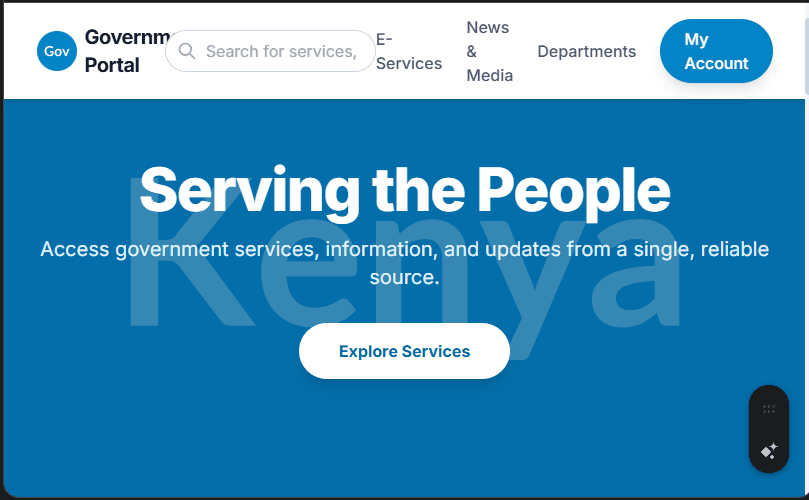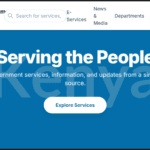Government/Public Sector Portal Website Design in Kenya
-
Delivery Time2 Weeks
-
English levelProfessional
Service Description
The cost of a Government/Public Sector Portal Website Design in Kenya is 80,000 KES. Get a Government/Public Sector Portal Website Design at Black Shepherd Technologies for 70,000 KES NOW!!.
We specialize in government portal design in Kenya, creating secure, transparent, and citizen-centric e-government platforms. Our solutions focus on digital service delivery, mobile-first accessibility, and open data to drive public sector digital transformation.
In Kenya’s journey toward a more efficient and transparent governance, a modern and well-designed government portal website is no longer a luxury—it’s a fundamental necessity. For public sector institutions, county governments, and state corporations, the website serves as the primary gateway for citizens to access information and essential services. This comprehensive guide outlines the strategic considerations, key features, and best practices for creating high-impact public sector websites and portals tailored specifically for the Kenyan context, a landscape defined by rapid digital transformation and a tech-savvy populace.
The transition to e-government aims to bridge the gap between citizens and public institutions. A successful government website must simplify complex bureaucratic processes, enhance transparency, and foster a new era of digital inclusion. The design must be citizen-centric, secure, and accessible to a diverse population, from urban centers to rural communities. This document will explore the core pillars that define excellence in public sector website design in Kenya.
Pillar 1: Citizen-Centric and User-Friendly Design
The primary user of a government website is the citizen. Therefore, the design philosophy must be citizen-centric, prioritizing a simple, intuitive, and frustration-free experience.
Intuitive Navigation: The website structure must be logical and easy to navigate. Users should be able to find the service or information they need in three clicks or less. This means moving away from a siloed, departmental approach and organizing content based on user needs, such as Find a Service, Learn About, Pay for a Service, or Download a Form.
Simplified Language: The content should be written in clear, simple language, free of technical jargon and bureaucratic terms. Where possible, provide information in both English and Swahili to cater to a wider audience, enhancing digital inclusion.
Consistent User Interface (UI): A uniform look and feel across all pages and sub-portals builds familiarity and trust. Consistency in the UI and user experience (UX) ensures that once a citizen learns how to use one part of the site, they can easily navigate others.
Pillar 2: Prioritizing Accessibility and Mobile-First Strategy
With Kenya’s exceptionally high mobile penetration, a mobile-first design strategy is non-negotiable for any public sector platform. The website must be a responsive design that adapts seamlessly to smartphones, tablets, and desktops.
Mobile Optimization: All forms, documents, and services must be fully functional and easy to use on a small screen. We optimize content for fast loading times, even on slower mobile networks, to ensure equitable access.
Accessibility Standards: The website must be designed to be accessible to all citizens, including those with disabilities. Adhering to international standards like the Web Content Accessibility Guidelines (WCAG) ensures features like text-to-speech options, keyboard navigation, and high-contrast visuals are in place. This commitment to website accessibility is critical for a truly inclusive government.
Multilingual Support: Providing the option to view the portal in both English and Swahili is a significant step towards reaching all Kenyans. This makes government information and services more approachable and understandable for everyone.
Pillar 3: Transparency and Accountability through Open Data
A government portal is the ultimate tool for promoting transparency and public accountability. The design should facilitate the easy publication and discovery of public information.
Open Data Portal: A dedicated section for open data, where the public can access and download public records, budgets, official statistics, and key government reports, is a cornerstone of modern public participation initiatives.
Official Document Repository: Centralize the publication of official documents such as the Kenya Gazette, Bills, Acts of Parliament, and public notices. A well-organized, searchable repository with clear publication dates builds public trust.
Public Participation and Feedback: The portal should provide a mechanism for citizens to submit feedback, report issues, and participate in policy discussions. This could include online surveys, public comment forms, and links to parliamentary committee proceedings.
Pillar 4: Security, Trust, and Seamless Digital Service Delivery
The provision of online service delivery and the handling of sensitive citizen data require a platform built on the pillars of data security and trust.
Secure Portals: All transaction-based services, such as applying for a passport, paying taxes, or renewing a driving license, must be hosted on secure sub-portals. Implement robust cybersecurity measures, including SSL encryption, multi-factor authentication, and secure payment gateways, to protect citizen data.
Integration with Key Services: The website should serve as a central hub, integrating with existing and future e-government services. This includes seamless links to the e-Citizen portal for integrated services, the Kenya Revenue Authority (KRA) for tax filings, and other sector-specific portals.
Service Locator: For services that still require physical presence, such as visiting a registry office or a local health facility, a map-based service locator is an invaluable tool. It connects the digital experience with the physical infrastructure of government.
Pillar 5: Keyword-Rich Content and Information Architecture
To ensure citizens can find what they need, the website’s content and underlying structure must be optimized for search engines and user discovery.
Keyword Strategy: We use a keyword-rich strategy that incorporates terms like government services Kenya, county government websites, public sector digital transformation, online land records, business registration Kenya, and e-Citizen services to improve search engine rankings and make information more discoverable.
FAQs and Knowledge Base: A comprehensive frequently asked questions (FAQ) section and a searchable knowledge base help to preemptively answer common citizen queries, reducing the burden on call centers and improving user satisfaction.
In conclusion, designing a modern government and public sector portal in Kenya is a complex but crucial undertaking. It requires a strategic and holistic approach that goes beyond aesthetics to focus on functionality, security, accessibility, and transparency. By creating a citizen-centric, mobile-first, and secure platform, the government can not only streamline its operations but also foster a more engaged, informed, and trusting relationship with the Kenyan public. This is the essence of a truly successful e-government platform.







